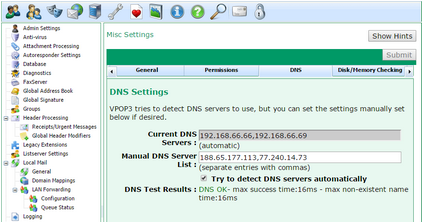
To get to this page, go to Settings → Misc Settings -> DNS.
This page lets you set the DNS servers which VPOP3 will use for many DNS lookups, such as MX lookups when performing SMTP Direct sending, or SPF checks or spam filter tests.
(Note that for some DNS lookups, VPOP3 will always use the default DNS server(s) configured in Windows, ignoring these settings, but it only uses those for simple 'A' record lookups which don't have any performance requirements. It doesn't use them for MX, TXT or PTR record lookups or bulk lookups such as those done by the spam filter.)
By default VPOP3 will detect the default DNS server(s) configured in Windows and use those, but you can override them by typing the IP addresses of the DNS servers to use in the Manual DNS Server List and unchecking the Try to detect DNS servers automatically box.
The Current DNS Servers box tells you which DNS servers VPOP3 is using for its own DNS lookups. Below that box it will display either "automatic" if VPOP3 is using the DNS servers configured in Windows or "manual" if it is using the manually specified DNS servers. This is changed by checking or unchecking the Try to detect DNS servers automatically box and submitting the page.
While this page is being displayed, VPOP3 will periodically run tests against the Current DNS Servers to measure their performance. This is displayed in the DNS Test Results section. It will perform a test lookup for a valid DNS name, and also for a non-existent name, and display how long it takes to receive the DNS response to both these tests.
If the tests are taking a long time to respond, then that will adversely affect the performance of VPOP3, especially for SMTP Direct sending and for the spam filter.
Sometimes some DNS servers are badly configured and do not respond at all for non-existent DNS name lookups. In this case you will see an error reported here. In this case it is worth changing the DNS server that VPOP3 uses.
Note that it is often best to use a local DNS server rather than one across the Internet because it will be faster, but this is only the case if you have a good DNS server such as BIND, SimpleDNS Plus or the Windows Server DNS service (there are other good DNS servers as well). The DNS service built into many low-end routers is often badly behaved so, if that is the only option for a local DNS server, it may be better to use either your ISP's DNS servers or the Google public DNS servers (8.8.8.8 & 8.8.4.4) or OpenDNS public DNS servers (208.67.222.222 and 208.67.220.220).

